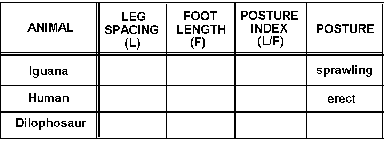The best way to find the posture index for this dinosaur is to use the footprints in the
corridor trackway to get values for dilophosaur leg spacing and foot length, and then
calculate posture index as you have already done for yourself and the iguana.
Finding dilophosaur foot length is straightforward. However, how to measure leg spacing
may not be immediately obvious because the trackway was made by a moving dilophosaur, not
one standing still with its legs together. As a result, the trackway footprints are
positioned at a considerable distance from each other along the trackway, rather than
opposite each other in the trackway, as would have been the case had the dinosaur stood
still.
One suggestion for measuring leg spacing, involving a line laid along the midline of the
trackway, is diagrammed to the left. If you decide to do this, you will need to lay a
length of twine, string or other material on the trackway to make the necessary
measurements.
Calculate posture index for a dilophosaur, record your results in the table above, and go
on to page 6.







